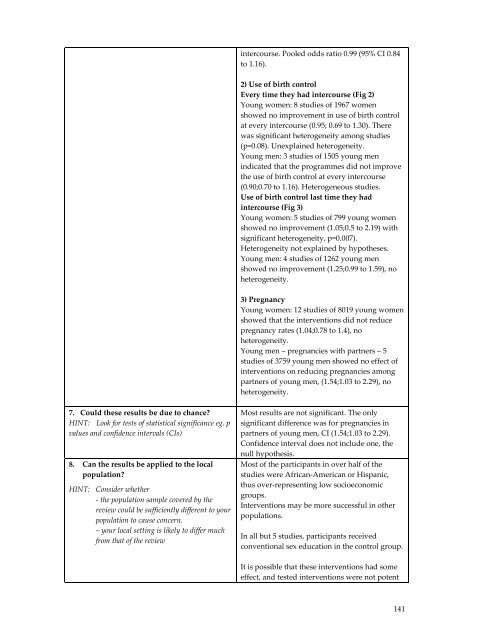Train the Trainer Course book - Cochrane Public Health Group
Train the Trainer Course book - Cochrane Public Health Group
Train the Trainer Course book - Cochrane Public Health Group
Create successful ePaper yourself
Turn your PDF publications into a flip-book with our unique Google optimized e-Paper software.
intercourse. Pooled odds ratio 0.99 (95% CI 0.84<br />
to 1.16).<br />
2) Use of birth control<br />
Every time <strong>the</strong>y had intercourse (Fig 2)<br />
Young women: 8 studies of 1967 women<br />
showed no improvement in use of birth control<br />
at every intercourse (0.95; 0.69 to 1.30). There<br />
was significant heterogeneity among studies<br />
(p=0.08). Unexplained heterogeneity.<br />
Young men: 3 studies of 1505 young men<br />
indicated that <strong>the</strong> programmes did not improve<br />
<strong>the</strong> use of birth control at every intercourse<br />
(0.90;0.70 to 1.16). Heterogeneous studies.<br />
Use of birth control last time <strong>the</strong>y had<br />
intercourse (Fig 3)<br />
Young women: 5 studies of 799 young women<br />
showed no improvement (1.05;0.5 to 2.19) with<br />
significant heterogeneity, p=0.007).<br />
Heterogeneity not explained by hypo<strong>the</strong>ses.<br />
Young men: 4 studies of 1262 young men<br />
showed no improvement (1.25;0.99 to 1.59), no<br />
heterogeneity.<br />
3) Pregnancy<br />
Young women: 12 studies of 8019 young women<br />
showed that <strong>the</strong> interventions did not reduce<br />
pregnancy rates (1.04;0.78 to 1.4), no<br />
heterogeneity.<br />
Young men – pregnancies with partners – 5<br />
studies of 3759 young men showed no effect of<br />
interventions on reducing pregnancies among<br />
partners of young men, (1.54;1.03 to 2.29), no<br />
heterogeneity.<br />
7. Could <strong>the</strong>se results be due to chance?<br />
HINT: Look for tests of statistical significance eg. p<br />
values and confidence intervals (CIs)<br />
8. Can <strong>the</strong> results be applied to <strong>the</strong> local<br />
population?<br />
HINT: Consider whe<strong>the</strong>r<br />
- <strong>the</strong> population sample covered by <strong>the</strong><br />
review could be sufficiently different to your<br />
population to cause concern.<br />
– your local setting is likely to differ much<br />
from that of <strong>the</strong> review<br />
Most results are not significant. The only<br />
significant difference was for pregnancies in<br />
partners of young men, CI (1.54;1.03 to 2.29).<br />
Confidence interval does not include one, <strong>the</strong><br />
null hypo<strong>the</strong>sis.<br />
Most of <strong>the</strong> participants in over half of <strong>the</strong><br />
studies were African-American or Hispanic,<br />
thus over-representing low socioeconomic<br />
groups.<br />
Interventions may be more successful in o<strong>the</strong>r<br />
populations.<br />
In all but 5 studies, participants received<br />
conventional sex education in <strong>the</strong> control group.<br />
It is possible that <strong>the</strong>se interventions had some<br />
effect, and tested interventions were not potent<br />
141








